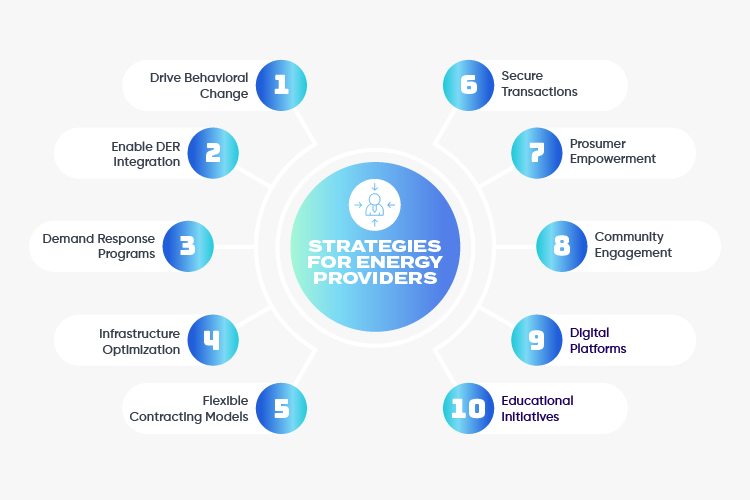Innovating the Grid: Strategies for People and Sustainability

In the not-so-distant past, the energy landscape was characterized by centralized systems, predictability, and one-way communication from the utility to the consumer. However, the winds of change are blowing, and the energy sector is transforming radically.
The future promises a paradigm shift towards a distributed, intermittent, and dynamic energy ecosystem that is modern, innovative, and sustainable. Let's delve into this energy evolution and explore the strategies and initiatives that will shape the industry's future.
Empowering People for Grid Resilience
When it comes to grid management, initiating the transition necessitates active engagement with people. This foundational step is imperative to effectively manage the grid's complexities and to foster a collaborative approach to sustainable energy practices. When individuals are engaged in the process, they become active participants in shaping the energy landscape. Understanding and involving end-users in the broader context of grid management not only enhances the efficiency of energy distribution but also promotes a sense of ownership and responsibility among consumers.
The significance of engaging with people becomes even more pronounced when clean energy becomes a focal point. Clean energy sources, such as solar and wind, are inherently intermittent and decentralized. By involving consumers in the management of these dynamic energy sources, a more resilient and adaptable grid infrastructure can be established. This engagement facilitates the integration of distributed energy resources (DERs), demand response initiatives, and community-driven efforts, creating a synergy that enhances grid reliability and sustainability. In essence, the journey toward a clean energy future begins with people, highlighting the pivotal role they play in building a grid that is responsive to the demands of a modern, innovative, and sustainable energy ecosystem.
Building a Connected Ecosystem in the New Energy Reality
To navigate the clean energy landscape and build grid resiliency, a connected energy ecosystem is imperative. This includes critical components such as energy storage, smart grids, prosumers, energy distribution, eMobility integration, public awareness, innovation, government policies, environmental impact, and economic aspects. These elements form the backbone of a system that is efficient and environmentally conscious.
The Era of Prosumers: Driving the Energy Revolution
The emergence of prosumers marks a significant shift from traditional energy consumption models. Prosumers actively participate in the utility ecosystem by deploying distributed generation, adopting connected technologies, and contributing to energy conservation. The expansion of energy efficiency, utility-scale storage, and the integration of new market participants, coupled with the harnessing of big data, are defining features of this new era.
Strategies for Energy Providers to Empower the Energy Transition
As the energy landscape transforms, energy providers must embrace strategic initiatives to empower this transition effectively. Here are some key strategies:

- Drive Behavioral Change: Incentivizing behavioral change involves creating reward systems for consumers who adopt energy-efficient practices. By offering discounts, loyalty programs, or rebates tied to reduced energy consumption, energy providers can motivate users to embrace sustainable habits, contributing to lower emissions and overall energy conservation.
- Enable DER Integration: Integrating Distributed Energy Resources (DERs) empowers energy providers to decentralize energy production. Providers can create a more resilient and flexible power system by incorporating solar panels, wind turbines, and other DERs into the grid. This shift towards localized power generation enhances reliability and reduces dependence on centralized sources.
- Demand Response Programs: Demand response programs allow energy providers to engage consumers actively in load management. By encouraging customers to shift their energy usage during peak demand periods, utilities can mitigate stress on the grid, reduce the need for additional infrastructure, and promote a more sustainable energy consumption pattern.
- Infrastructure Optimization: Infrastructure optimization involves leveraging advanced technologies like grid management and microgrid integration. By strategically placing microgrids and utilizing smart grid solutions, energy providers can enhance the efficiency of their infrastructure. This reduces operational costs and minimizes environmental impact by optimizing energy distribution.
- Flexible Contracting Models: Offering flexible contracting models involves tailoring contracts to meet individual consumer needs. Energy providers can design agreements that align with customers' preferences, providing options like time-of-use pricing, green energy plans, and variable-rate contracts. This adaptability ensures prosumers have choices that suit their lifestyles while promoting sustainable energy consumption.
- Secure Transactions: Ensuring secure transactions is paramount in the digital era of energy management. Utilities must implement robust cybersecurity measures to protect customer data and maintain the integrity of transactions. Establishing trust in data security safeguards consumer information and promotes confidence in adopting digital energy solutions.
- Prosumer Empowerment: Empowering prosumers involves enabling customers to generate, monitor, and share their energy. Energy providers can facilitate the installation of solar panels and home energy systems, allowing consumers to become active contributors to the grid. By empowering prosumers, utilities can foster a sense of ownership and environmental responsibility among their customer base.
- Community Engagement: Community engagement initiatives create platforms for local energy communities to share knowledge and resources. Energy providers can organize events, workshops, and collaborative projects that encourage community members to pursue sustainability goals collectively. Fostering a sense of shared responsibility strengthens the local energy ecosystem and builds a resilient, interconnected community.
- Digital Platforms: Providing user-friendly digital platforms is essential for enhancing customer control over energy consumption. Energy providers can offer intuitive apps and online platforms that allow users to monitor their energy usage in real-time, control smart home devices, and access personalized insights. These digital tools empower consumers to make informed decisions, promoting energy efficiency.
- Educational Initiatives: Educational initiatives involve actively informing customers about the benefits of clean energy practices. Utilities can provide personalized insights and outreach programs to educate consumers on energy conservation, the environmental impact of their choices, and the advantages of adopting renewable energy sources. By fostering awareness, energy providers can empower consumers to make sustainable choices in their energy consumption habits.
The journey toward a clean energy future is both exciting and challenging. By embracing innovation, forging partnerships, and adopting strategic initiatives, the energy industry can adapt to the changing landscape and lead the charge toward a sustainable and resilient future. By integrating grid management into this transformative journey, the industry can actively shape an energy ecosystem that benefits us all and leaves a positive legacy for generations to come.
Introducing GridExchange - SmartGX by SEW, a blockchain-based software platform that enables customers to participate in an energy marketplace with their utility. Available on the web and mobile, the GridExchange platform features a secure, real-time energy exchange with a robust settlement process with instant financial compensation and rewards. To know more about the GridExchange platform, reach out to us.





